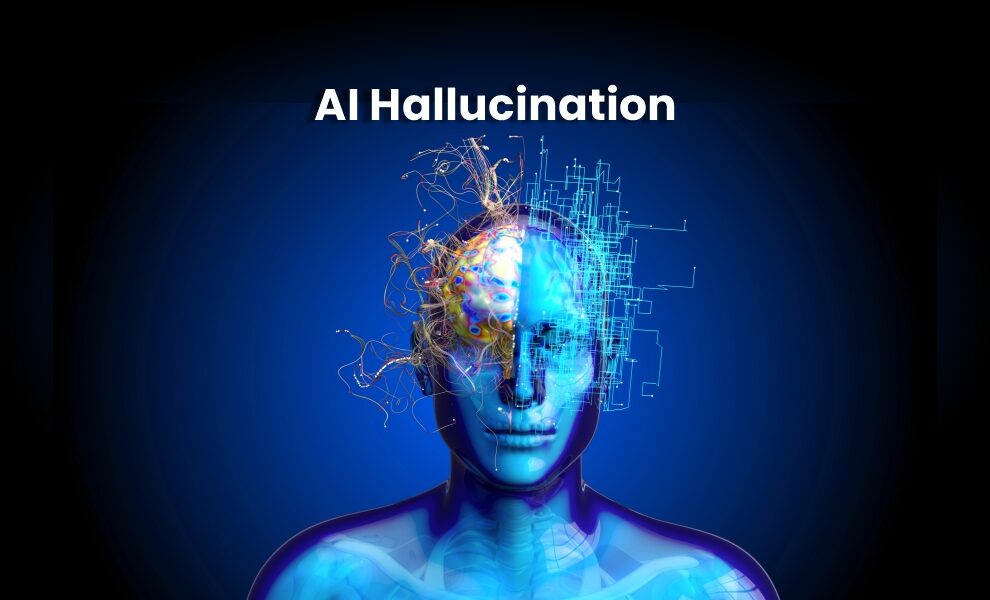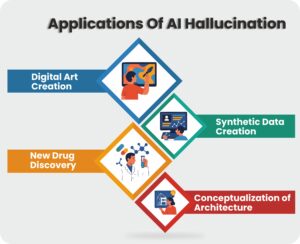Everyone has experienced asking an AI assistant for information and getting a confident, wholly made-up response. These so-called “hallucinations” are not caused by renegade machines becoming imaginative. This quirk in artificial intelligence’s information processing and generation is pretty interesting.
Recent findings from Gen AI startup Vectara reveal how common this phenomenon is. Chatbots will fake information anywhere from 3% to 27% of the time. That means in some worst-case scenarios, more than one in four AI responses could contain made-up facts or connections. As these tools become more and more integrated into our everyday routines and lives, it is a frightening fact.
We will learn about it in detail in this blog below…
What Are AI Hallucinations?
When AI models produce information that seems reasonable, but it is either entirely fabricated or factually inaccurate, this is known as AI hallucination. These are not careless errors; rather, they are basic problems with the way huge language models interpret and produce text, resulting from training-induced patterns rather than actual comprehension. This phenomenon is known in the technical field as “confabulation” or “synthetic content divergence.”
It occurs because these algorithms anticipate what words should appear next based on statistical patterns rather than accessing a validated library of facts. The model automatically generates text that preserves linguistic coherence at the price of factual correctness when it enters information-sparse areas or comes across unclear prompts. In high-stakes fields like science, medicine, and law, this conduct presents an especially challenging issue.
Why Are AI Hallucinations A Problem?
At first look, AI hallucinations may appear harmless. However, in real-world scenarios, they can be very harmful. When an AI confidently presents erroneous information as fact, users without specialized knowledge are unable to distinguish fact from fiction. These inaccurate outputs have the ability to quickly spread false information when shared online or incorporated into decision-making procedures.
In vital domains like healthcare, legal analysis, or financial guidance, hallucinated content might have catastrophic consequences. Think about a medical AI recommending treatments in a hallucination or a legal AI fabricating case precedent. The “black box” aspect of many AI systems makes this problem worse.
The way hallucinations deteriorate confidence in AI systems, in general, is arguably the most worrisome. Every time users come across false information, their trust in AI is undermined. They develop reasonable doubts about its dependability. This lack of trust may impede the adoption of useful AI technology across industries, in addition to having an impact on individual installations. We run the risk of causing a technological trust gap.
AI Hallucination Applications:
Digital Art Creation: Neural networks are now able to produce previously unimaginable works of art. The distinction between creativity and computation is blurred by these hallucinogenic figures. Diffusion models that have been trained on billions of photos are used for the synthesis. It gradually picks up new techniques for extracting and recombining visual aspects.
Synthetic Data Creation: Hallucinated datasets are a great way to fill the void left by the lack of real-world data. Using this artificial data, engineers train models to address issues without worrying about privacy. The fake data avoids gathering sensitive information while simulating the statistical characteristics of real samples.
New Drug Discovery: To create artificially plausible molecular structures that may never exist in nature, pharmaceutical researchers use generative algorithms. Promising candidates for the treatment of resistant diseases have already been found by these computational daydreams.
Conceptualization of Architecture: Architects today work with machines that create impossible structures, drawing inspiration from forms created by machines. By proposing unusual spatial relationships and building techniques, these hallucinated designs push the bounds of creativity.
How To Prevent AI Hallucinations?
Instead of depending only on parametric information, the best systems use retrieval-augmented generation to anchor responses in documented sources. It is easier said than done, systems should accept uncertainty rather than fabricate specifics when they are unable to validate something with high confidence.
Nothing compares to the perceptive eye of a qualified human reviewer with topic understanding, even with the aid of technical safeguards. These systems can be made more resistant to common hallucination triggers that could otherwise lead to fabrication by being trained on adversarial cases.
Concluding Remarks!
Advanced systems’ hallucinations provide as much insight into human cognition as they do into reasoning powered by silicon. These lines will probably become even more hazy in the future as technologies advance, turning today’s flaws into tomorrow’s advantages. Learning to effectively use these digital daydreams rather than completely avoiding them may be the most intriguing path. Developing systems that are able to distinguish between sticking to the facts and dreaming.
To know more about AI Hallucinations and other latest technologies, visit us at HiTechNectar.
Read More: How AI Agents and Assistants Shape Our World Differently



